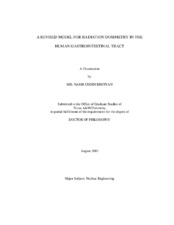| dc.description.abstract | A new model for an adult human gastrointestinal tract (GIT) has been developed for use in internal dose estimations to the wall of the GIT and to the other organs and tissues of the body from radionuclides deposited in the lumenal contents of the five sections of the GIT. These sections were the esophagus, stomach, small intestine, upper large intestine, and the lower large intestine. The wall of each section was separated from its lumenal contents. Each wall was divided into many small regions so that the histologic and radiosensitive variations of the tissues across the wall could be distinguished. The characteristic parameters were determined based on the newest information available in the literature. Each of these sections except the stomach was subdivided into multiple subsections to include the spatiotemporal variations in the shape and characteristic parameters. This new GIT was integrated into an anthropomorphic phantom representing both an adult male and a larger-than-average adult female. The current phantom contains 14 different types of tissue. This phantom was coupled with the MCNP 4C Monte Carlo simulation package. The initial design and coding of the phantom and the Monte Carlo treatment employed in this study were validated using the results obtained by Cristy and Eckerman (1987). The code was used for calculating specific absorbed fractions (SAFs) in various organs and radiosensitive tissues from uniformly distributed sources of fifteen monoenergetic photons and electrons, 10 keV - 4 MeV, in the lumenal contents of the five sections of the GIT. The present studies showed that the average photon SAFs to the walls were significantly different from that to the radiosensitive cells (stem cells) for the energies below 50 keV. Above 50 keV, the photon SAFs were found to be almost constant across the walls. The electron SAF at the depth of the stem cells was a small fraction of the SAF routinely estimated at the contents-mucus interface. Electron studies showed that the “self-dose” for the energies below 300 keV and the “cross-dose” below 2 MeV were only from bremsstrahlung and fluorescent radiations at the depth of the stem cells and were not important. | en |


